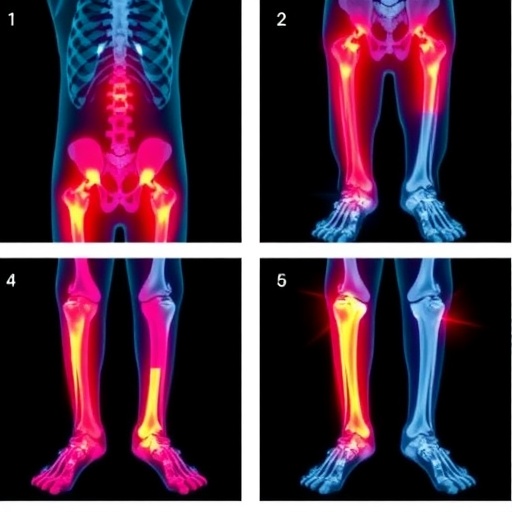In the relentless battle against cancer, the tumor microenvironment (TME) has emerged as a critical battlefield influencing disease progression and therapeutic outcomes. Recent groundbreaking research has illuminated the complex metabolic reprogramming and functional crosstalk that occurs within the TME, highlighting new avenues for multi-omics approaches to effectively combat malignancies. This intricate interplay between cancer cells and their surrounding milieu not only fuels tumor growth but also orchestrates immunosuppression, angiogenesis, and therapy resistance, underscoring the necessity of holistic, system-wide investigative strategies.
The tumor microenvironment is not a passive backdrop but a dynamic ecosystem composed of cancer cells, stromal cells, immune infiltrates, extracellular matrix components, and a plethora of signaling molecules. These constituents engage in a sophisticated web of communication, facilitating adaptive metabolic rewiring that enables tumor cells to survive and proliferate even under harsh conditions such as hypoxia or nutrient scarcity. Metabolic flexibility manifests prominently in altered glucose metabolism, lipid signaling, and amino acid pathways, creating a metabolically hostile microenvironment that paradoxically supports tumor resilience.
.adsslot_IO4RhkU2fz{ width:728px !important; height:90px !important; }
@media (max-width:1199px) { .adsslot_IO4RhkU2fz{ width:468px !important; height:60px !important; } }
@media (max-width:767px) { .adsslot_IO4RhkU2fz{ width:320px !important; height:50px !important; } }
ADVERTISEMENT
Another pivotal discovery entails the functional crosstalk mediated by metabolic intermediates and secreted factors. Lactate, previously considered a mere waste product, now emerges as a central oncometabolite facilitating immune evasion by promoting regulatory T-cell differentiation and suppressing cytotoxic T lymphocytes. Similarly, tumor-derived exosomes transport metabolic enzymes and microRNAs that reprogram recipient stromal and immune cells, thereby sculpting a microenvironment conducive to tumor progression and metastasis. Such bidirectional communication challenges the paradigm of targeting cancer cells alone, hinting at the necessity of intercepting these metabolic dialogues.
Hypoxia-inducible factors (HIFs) act as master regulators of metabolic adaptation within the TME. In hypoxic niches, HIF-driven transcriptional programs upregulate glycolytic enzymes and angiogenic factors, supporting vascular remodeling and nutrient supply. This adaptation, while aiding tumor survival, also imposes immunosuppressive effects through accumulation of adenosine and modulation of immune checkpoints. The metabolic penalties exacted by hypoxia thus ripple through the TME, altering cellular phenotypes and responses to therapy, offering insights for rational drug development.
The integration of metabolomic profiling has unveiled unique metabolic fingerprints that correlate with tumor aggressiveness and therapy response. Mass spectrometry-based analyses identify differential abundance of key metabolites such as glutamine, serine, and fatty acids, which serve as both diagnostic markers and therapeutic targets. Targeting these metabolic nodes, either through enzyme inhibition or nutrient restriction, demonstrates promising antitumor efficacy in preclinical models, underscoring the translational potential of metabolic interventions.
Importantly, the application of multi-omics data supports the stratification of patients based on their TME metabolic landscape, enabling precision oncology approaches. By mapping tumor-stroma interactions and metabolic fluxes, clinicians can predict resistance mechanisms and tailor combination therapies that simultaneously inhibit cancer cell metabolism and modulate the immune milieu. Such personalized strategies are expected to enhance efficacy while minimizing off-target toxicities, revolutionizing cancer treatment paradigms.
Emerging therapeutics aim to disrupt specific metabolic exchanges within the TME to dismantle the supportive infrastructure sustaining tumors. Inhibitors of monocarboxylate transporters (MCTs), responsible for lactate shuttling between stromal and cancer cells, have shown significant promise. These agents effectively starve cancer cells of critical metabolites and reprogram immune cells to a pro-inflammatory phenotype. Combining such metabolic inhibitors with immune checkpoint blockade holds tremendous potential to synergistically reinvigorate antitumor immunity.
Moreover, lipid metabolism reprogramming within the TME has gained attention for its role in modulating membrane dynamics, signaling cascades, and energy homeostasis. Alterations in fatty acid synthesis and beta-oxidation influence not only cancer cell proliferation but also macrophage polarization towards tumor-promoting phenotypes. Pharmacological targeting of key enzymes such as fatty acid synthase (FASN) and carnitine palmitoyltransferase 1 (CPT1) can reverse these effects, offering new therapeutic windows.
The multi-omics approach further unravels the complexity of amino acid metabolism in the TME. Cancer cells frequently depend on non-essential amino acids like glutamine and serine for nucleotide biosynthesis, redox balance, and epigenetic regulation. Concurrently, immune cells within the TME undergo metabolic constraints due to amino acid depletion, leading to impaired effector functions. Strategies to restore amino acid availability or inhibit cancer cell uptake pathways could rebalance this metabolic tug-of-war, enhancing immunosurveillance.
Epigenetic regulation in response to metabolic shifts also figures prominently in shaping the TME. Metabolites such as alpha-ketoglutarate and succinate function as cofactors or inhibitors of chromatin-modifying enzymes, influencing gene expression and cellular identity. These findings highlight an additional layer whereby metabolism affects tumor biology beyond energy production, providing further targets for intervention.
Beyond the cellular and molecular changes, metabolic reprogramming influences extracellular matrix remodeling and angiogenesis, contributing to tumor invasiveness. Enzymes like matrix metalloproteinases (MMPs) activated by metabolic cues degrade extracellular barriers, facilitating metastasis. Angiogenic switch induced by metabolic stress ensures sustained nutrient delivery but creates aberrant vessels that hinder drug penetration. Therapeutic strategies integrating metabolic modulation with normalization of the tumor vasculature promise improved drug delivery and efficacy.
As this field advances, artificial intelligence and machine learning emerge as indispensable tools for integrating vast multi-omics datasets, uncovering hidden metabolic networks and predictive biomarkers within the TME. Such computational frameworks accelerate hypothesis generation and validation, enabling rapid clinical translation. The convergence of technology and biology heralds a new era of precision oncology, where metabolic vulnerabilities are exploited to outmaneuver even the most recalcitrant tumors.
The study of metabolic reprogramming and functional crosstalk within the tumor microenvironment underscores that cancer is not merely a cellular disease but a systemic metabolic disorder. Holistic, multi-omics approaches provide unprecedented resolution, exposing the intricate dependencies that tumors forge with their surroundings. This knowledge enables the development of innovative combinatorial therapies aimed at metabolic circuits, immune modulation, and microenvironmental remodeling, potentially overcoming longstanding barriers in cancer treatment.
Ultimately, harnessing the insights from metabolic reprogramming within the tumor microenvironment offers hope for durable responses and long-term remission. By targeting the very processes that permit tumors to adapt and evade, this research opens transformative paths toward conquering cancer, promising a future where malignant growths can be controlled and even eradicated through precision metabolic interventions.
Subject of Research: Metabolic reprogramming and functional crosstalk within the tumor microenvironment and a multi-omics anticancer approach
Article Title: Metabolic reprogramming and functional crosstalk within the tumor microenvironment (TME) and A Multi-omics anticancer approach
Article References:
Mir, R., Javid, J., Ullah, M.F. et al. Metabolic reprogramming and functional crosstalk within the tumor microenvironment (TME) and A Multi-omics anticancer approach. Med Oncol 42, 373 (2025). https://doi.org/10.1007/s12032-025-02945-5
Image Credits: AI Generated
Tags: amino acid pathways in TMEangiogenesis in the tumor microenvironmentcancer-associated fibroblasts rolesglucose metabolism alterations in tumorshypoxia and tumor metabolismimmune cell interactions in TMEintegrative cancer research strategieslipid signaling in cancermetabolic reprogramming in cancermulti-omics approaches in oncologytherapeutic resistance mechanismstumor microenvironment insights





